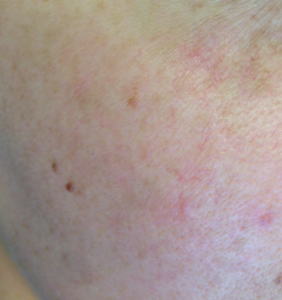Angioma
The angioma is also defined by the term ‘Child-Angioma or Hemangioma’ and typically affects the skin of the face (those of the mucous membranes are rare).
Angioma have a large variability in clinical/colours manifestation; from pale pink to dark red to bluish (often with the passing of the months or even years the same malformation changes color), they can be flat (called ‘Flat Angioma) or more or less prominent (‘Cavernous Angioma), have an elastic consistency, with a smooth or granular surface and may have more or less defined margins.
In most cases, after a growing-time, the angioma tends to shrink until complete disappearance (sometimes a small scar may hesitate) and if the regression is incomplete it is possible to treat them with specific lasers with excellent results.
In the most serious cases this malformation can evolve assuming variable volumes and forms, sometimes dramatic from an aesthetic and functional point of view; for this type of malformations a multidisciplinary approach is often required.
Among the angiomas, the most frequently found is the Spider Angioma (or Spider Naevi) that is caused by the dilatation of an arteriole of the skin (dermis) from which they branch out of the small branches. Often It is red and if compressed in the middle it pales because no more blood flows inside. The face is the most common place of localization even though it may be present in the upper half of the body. It does not cause any kind of disturbance and therefore represents only an aesthetic problem easily solved with laser treatment. The causes for this type of angioma are not known; probably estrogen hormones may be involved in the genesis of this malformation due to the frequent finding of it in women who have been taking birth control pills for many years or in pregnant women but there is no certainty about it. Sometimes they are also present in some pathological conditions that affect the liver as in the case of cirrhosis exotoxin (alcoholism) or viral infection (hepatitis C virus)
LASER:
the most suitable technique for the treatment of Angiomas is the Laser.
There are different types of lasers for the treatment of angioma depending on the characteristics of the angioma itself such as color, size or extension and type of patient such as age, phototype etc…
A single laser session is sufficient to remove small Angioma, while for other types more sessions are needed with a distance of about 30 days between each other.
After the Laser treatment an healing and moisturizing cream is applied for about 20 days trying to avoid traumatism of the treated areas (for example drying the face by dabbing and not rubbing), using neutral detergents and avoiding the direct application of perfumes as well as the use of aggressive cosmetic products. A high sun screen is always necessary and if small scabs appear after the Laser treatment, there is no need to worry because they will fall down (it is important not to remove them!).
BEFORE AND AFTER:



